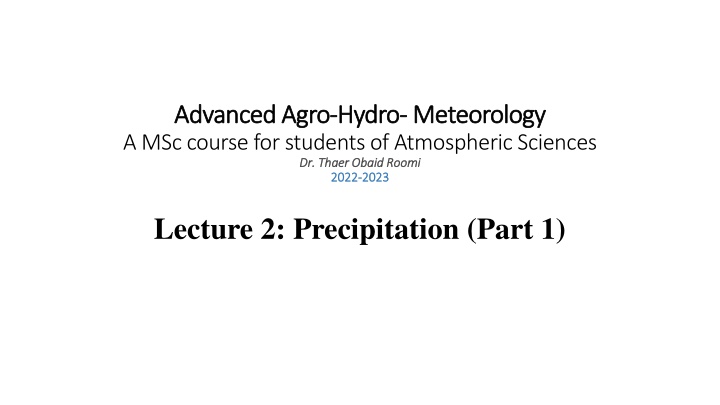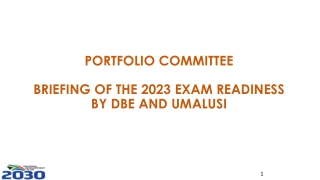
Advanced Agro-Hydro-Meteorology Course: Precipitation Dynamics and Thermodynamic Laws
Explore the intricate relationship between precipitation forms, water vapor, and thermodynamic laws in the field of atmospheric sciences. Learn about the laws governing precipitation, potential temperature, and the Clausius-Clapeyron Equation, vital for understanding weather patterns. Dive into topics such as dry adiabatic lapse rates, saturation vapor pressure, and more in this comprehensive course for aspiring meteorologists and atmospheric scientists.
Uploaded on | 1 Views
Download Presentation

Please find below an Image/Link to download the presentation.
The content on the website is provided AS IS for your information and personal use only. It may not be sold, licensed, or shared on other websites without obtaining consent from the author. If you encounter any issues during the download, it is possible that the publisher has removed the file from their server.
You are allowed to download the files provided on this website for personal or commercial use, subject to the condition that they are used lawfully. All files are the property of their respective owners.
The content on the website is provided AS IS for your information and personal use only. It may not be sold, licensed, or shared on other websites without obtaining consent from the author.
E N D
Presentation Transcript
Advanced Agro Advanced Agro- -Hydro A MSc course for students of Atmospheric Sciences Dr. Thaer Obaid Roomi Dr. Thaer Obaid Roomi 2022 2022- -2023 Hydro- -Meteorology Meteorology 2023 Lecture 2: Precipitation (Part 1)
precipitation Forms: rain, drizzle, sleet (partly melted snowflakes, or rain and snow falling together), snow and hail. Source: Water vapor Water vapor: always present, varying amounts, less than 1% by volume. Water vapor cooling condensation cloud droplets. Equation of state ? = ??? Boyle s law: ?1?1= ?2?2 Charles law: ?2 ?? ???????? ? ?1 ?1=?2 at constant ?
First First law of law of thermodynamics thermodynamics ?? = ?? + ?? ?? = ???? + ? ?? ?? = ???? ? ?? where ??= ? + ??= 1004 ??? 1? 1 Atmospheric processes: dry adiabatic lapse rate ???? + ? ?? = 0 ???? ? ?? = 0 ? ?1= (? If T increases, ? will decrease and vice versa. (1) (2) ??= 717 ??? 1? 1 and ?1) ? (3) ?? ? ?? ? ?1= (? If T increases P will increases and vice versa. Question: Derive Eq.3 and Eq.4 ?1) (4)
Potential temperature and DALR We may define potential temperature ? as follows: ? 1000 ? ? = ? (2.13) Where ? = ?/??. Therefore, ? is a constant for a dry adiabatic process, that is, one with no condensation or evaporation. Knowing that the hydrostatic equation is: ?? ??= g ? From equation (???? ? ?? = 0), and differentiating with respect to height z, and using (2.14): ?? ?? ??? ?? ??= g ?? ??= g/??= ??= 9.76?? ?? 1 Therefore if a parcel of air rises dry adiabatically, its temperature will fall at the rate of about 10 C km 1. The quantity ??is the dry adiabatic lapse rate (DALR). (2.14) ?? ??= 0 ?? (2.15)
The The Clausius Clausius- -Clapeyron Clapeyron Equation Equation Clausius-Clapeyron equation calculates the change of the saturation vapor pressure with temperature (des/dT) during a phase change. ??? ??= ?(?2 ?1) If ?12, ?1and ?2are known functions of T, then (2.16) can be integrated to obtain a relation between saturation vapor pressure and T. Since ?2 ?1(specific volume of water vapor is much greater than specific volume of liquid water or ice), equation 2.16 becomes: ??? ??=?12 ??2 From the equation of state (?2= ???/??) we get: ??? ?? ?? ?2 Therefore, ?? ??0 ?? Where ??0is the saturation vapor pressure at ?0. ?12 (2.16) (2.17) =?12 ?? (2.18) =?12 1 ?0 1 ln (2.19) ?
For evaporation, ??0= 6.11 mb and ?0= 273 ? , which implies mb and To=273 K, which implies ?? 6.11 ?? ??= 6.11 ?? exp[????? =????? ?? 273 1 1 ln (2.20) ? 1 273 1 or ?] (2.21) ?? For sublimation, ?? =???? ?? 273 1 1 ln (2.22) 6.11 ?? ??= 6.11 ?? exp[???? ? 1 273 1 or ?] (2.23) ?? Ex: Calculate the change in the melting point of ice if the pressure is increased from 1 to 2 atm, given that: ??= 1.0908 10 3?3?? 1, ??= 1.001 10 3?3?? 1 ?????= 3.34 105??? 1 Solution: Using Clausius-Clapeyron equation, ?? 0?? ?? ????? ?? = ?(?? ??) = 273 (1.001 1.0908) 1.013 105/3.34 105= 0.00744 ??? Therefore, an increase in pressure of 1 atm decreases the melting point of ice by about 0.007 deg. Usually, the melting point increases with increasing pressure. But ice is unusual because ??< ??.
Equations (2.20) and (2.22) plus a similar equation for melting allow us to plot the curves of saturation pressure versus temperature. These curves describe the T-e relations during phase changes (e=es).
All curves begin at the triple point. (a) Evaporation curve a: curves upward exponentially to the right (T > 273 K, and es > 6.11 mb). Along this curve, water and vapor are in equilibrium until it reaches the critical point (T = 374 K). At some point along this curve, water starts to boil. That is the point when es=patm. (b) Sublimation curve b: curves downward exponentially to the left of the triple point (T < 273 K, es< 6.11 mb). This curve is steeper than the evaporation curve because Lsub>Levap. (c) Melting curve c: since ?? ??is almost zero, des/dT is almost - . Thus the curve is almost vertical, but tilts very slightly to the left. (d) Supercooled water d: When water which does not freeze below 273 K (0oC), For supercooled water, within T < 0oC, esw> esi(curve d). Therefore, in a cloud with mixture of ice crystals and supercooled water (cloud) droplets, water vapor will first condense on the ice because esiis smaller than esw. In other words, ice will win over supercooled water. This leads to the well-known Bergeron-Findeison process. That is, ice crystal in a cloud of supercooled water droplets will grow faster than the water droplets.
Atmospheric processes: saturated adiabatic lapse rate Atmospheric processes: saturated adiabatic lapse rate For a sample of moist air in which no evaporation or condensation occurs, equation 2.16 may be used. ??? ??= ?(?2 ?1) However, when condensation occurs and the resulting water falls out of the sample, the mass of the sample changes and heat is lost with the fallout of the water. This is known as a pseudo adiabatic process. Hence, for saturated air which is lifted slightly, ?? 1 +? ?? ??? ?2?? ? ???2 ?12 ?? ??= ??= (2.17) 1 + where ??is the saturated adiabatic lapse rate (SALR) and ??is the saturated humidity mixing ratio, that is, the mass of water vapor present in the moist air measured per gram of dry air when the moist air is saturated. Although ??varies with temperature and pressure, a typical value in the atmosphere is 5.0 C km 1.
Stability and convection in the atmosphere Stability and convection in the atmosphere Moist air can become saturated, and hence produce precipitation, by movement upwards in the atmosphere. Consider a parcel of moist air, for which the pressure in the parcel is the same as that of its environment. Assuming that the parcel can move vertically without disturbing the environment and does not mix with its environment, it can be shown from the equations of motion for the atmosphere that ?? ??= ?? where w is the vertical velocity of the parcel, T is the temperature of the parcel, and T is the temperature of the environment. Making the further assumption that the movement is adiabatic, ?? ??= ?0 where ?0and ?0 lapse rate, z is the vertical coordinate, and ais the appropriate adiabatic lapse rate, being dif the parcel is unsaturated and sif the parcel is saturated. If the temperature is constant in the horizontal then ?0= ?0 ?? ??= ?0 The atmosphere is regarded as stable, neutral or unstable when dw/dt is <0, 0 or >0, respectively. If ??< ? < ?? then the atmosphere is conditionally unstable, whereas if ? < ??the atmosphere is absolutely stable and if ? > ??the atmosphere is absolutely unstable. Hence if moist air is lifted by some means it may become saturated and hence unstable, and may then continue to rise without any external force being applied. ? ? g ? ?? g = (2.18) g ?0 ?0 ? ??g ? ?0 + (2.19) are the initial temperature of the parcel and the environment respectively, is the environmental and ? ??g ? (2.20)
The growth of precipitation particles and Bergeron Process The growth of precipitation particles and Bergeron Process The movement of air upwards condensation of water vapor water droplets or ice crystals. Precipitation particles are denser than the air surrounding them begin to fall. These particles will either evaporate in unsaturated air below the cloud, or be held suspended by vertical currents within the cloud. These will reach the ground as precipitation if they become large enough. In order for cloud droplets to become rain drops, they have to increase in size almost a million times. Indeed, even the cloud droplet to form, complicated processes must take place.
Often times this process would be impossible without the presence of aerosols. Let us first examine the case without them, known as homogeneous nucleation. Condensation will occur when the relative humidity reaches 100%, or when the vapor pressure equals the saturation vapor pressure. In the microphysics of clouds condensation, however, pure water will condense only when levels of saturation reach upwards of 120% (20% supersaturation). The reason being that the spherical shape a water droplet forms is a very unstable structure, hence resisting formation of the droplet. It is not until these high levels of saturation are reached that the forcing will overcome this resistance known as surface tension. The process known as heterogeneous nucleation involves "polluting" the pure water with aerosols, or CCN. By adding CCN, water is allowed to condense with much lower values of supersaturation.
How the cloud droplets can grow to the size of a raindrop? One such way is through collision and coalescence. Cloud droplets will be carried by air currents within the cloud, and collide with each other. If they collide then stick together coalescence. Although this process is important, especially in the tropics and in increasing the size of raindrops, it is not the primary mechanism for the formation of raindrops. The process needed was the Bergeron process relies primarily on the fact that the saturation vapor pressure with respect to ice is less than the saturation vapor pressure with respect to water.
Because of surface tension and the structure of water, to get a pure water droplet to freeze requires a temperature of -40 C. The freezing nuclei, in contrast to CCN, are not plentiful in the atmosphere because there structure must be similar to the structure of an ice crystal. Most of the naturally occurring freezing nuclei "activate" at about -10 C. These freezing nuclei allow for the cloud droplets to freeze around them. Because of the relative sparseness of the freezing nuclei, ice crystals and supercooled water droplets can coexist at the same time.
The following chart illustrates the differences in saturation vapor pressures of water. Note that since RH= e/es, if es is made smaller, RH increases.
The Bergeron process can be summarized as such: The air reaches saturation and some of the resulting droplets will come in contact with freezing nuclei. There have a combination of ice crystals and supercooled water droplets. From the perspective of the supercooled droplets, the air is in equilibrium at saturation, but from the perspective of the ice crystals, the air is supersaturated. Therefore, water vapor will sublimate on the ice crystals. Since the amount of water vapor in the air has decreased, and from the perspective of the supercooled water droplet, the air is subsaturated, the supercooled water will evaporate until the air once again reaches saturation. The process then continues. In short summary, the ice crystal grows through sublimation at the expense of the supercooled water droplet.



















